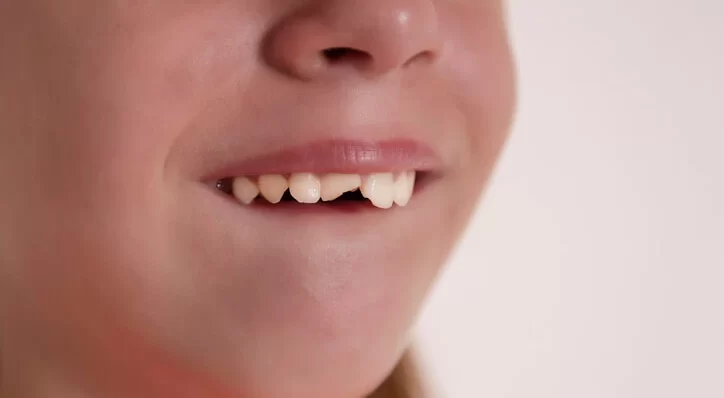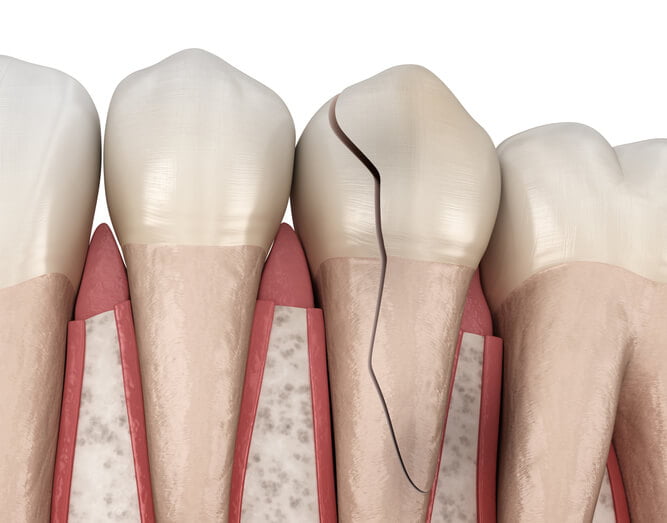The human tooth is a remarkably durable structure, yet it’s susceptible to fractures due to various factors such as trauma, decay, or biting on hard substances. Tooth fracture can be categorized based on its extent, location, and severity.
Table of Contents
ToggleClassification of Tooth Fracture
Ellis Classification is one of the most famous tooth fracture classifications:
Ellis Classification System
Dr. Ellis developed a widely used classification system for fractured teeth:
- Ellis I Fracture (Enamel Fracture): This involves the enamel, the outer layer of the tooth. It’s typically characterized by a chipped or broken tooth but doesn’t involve dentin or pulp.
- Ellis II Fracture (Enamel-Dentin Fracture): This type extends through the enamel and reaches the dentin, the layer beneath the enamel. This fracture exposes the dentin, causing sensitivity and potential pain.
- Ellis III Fracture (Enamel-Dentin-Pulp Fracture): This is the most severe type, reaching the pulp chamber where the nerves and blood vessels are housed. It requires immediate attention as it can lead to intense pain, infection, and complications.
Other Classifications
There are other classifications for tooth fracture such as:
Fracture Location
- Crown Fractures: These occur on the visible part of the tooth.
- Root Fractures: These fractures occur below the gum line and can be more challenging to detect and treat.
Severity Based on Extent
- Simple Fractures: Those that involve minimal damage and can often be repaired with conservative treatment.
- Complex Fractures: Involve extensive damage and may require more intricate treatment procedures.
Types of Tooth Fracture
- Vertical Root Fracture
- Craze Lines
- Greenstick Fracture
- Cuspal Fracture
Vertical Root Fracture
A vertical root fracture begins at the root and extends upward. They are often asymptomatic initially but can lead to inflammation and infection, necessitating root canal treatment or extraction.
Craze Lines
These are superficial cracks on the enamel that don’t cause pain or require treatment. They are commonly seen in adults and are mostly a cosmetic concern.
Greenstick Fracture
Commonly seen in children, a greenstick fracture is an incomplete fracture where the tooth is bent and damaged but not completely broken. Treatment involves stabilization and monitoring for further damage.
Cuspal Fracture
This involves the cusp or pointed part of the tooth, often due to trauma or large fillings. It can lead to increased susceptibility to fractures or tooth sensitivity.
Causes and Risk Factors
- Trauma: Accidents, falls, or sports injuries can cause tooth fracture.
- Chewing Hard Substances: Biting on hard objects or foods can lead to fractures.
- Caries (Tooth Decay): Weakened teeth due to decay are more prone to fractures.
- Bruxism (Teeth Grinding): Excessive grinding can weaken tooth structure.
Diagnosis of Tooth Fracture
- Clinical Examination: Visual inspection and dental instruments help determine the extent and type of fracture.
- X-rays: Radiographs are crucial for identifying fractures that are not visible to the naked eye, such as root fractures.
Treatment Options
- Bonding or Filling
- Root Canal Therapy
- Crown or Cap
- Extraction
Bonding or Filling
For minor fractures (Ellis I), the dentist may use bonding or filling materials to restore the tooth’s appearance and function.
Root Canal Therapy
For fractures involving the pulp (Ellis III), root canal treatment may be necessary to remove infected tissue and preserve the tooth.
Crown or Cap
Extensive fractures may require a crown or cap to restore the tooth’s structure and strength.
Extraction
In severe cases where the tooth cannot be saved, extraction may be necessary to prevent infection and maintain oral health.
Prevention
- Use of Mouthguards: Especially during sports activities to prevent trauma.
- Regular Dental Check-ups: Early detection of decay or structural issues can prevent fractures.
- Avoidance of Habits: Refraining from chewing hard objects or grinding teeth.
Complications and Long-Term Effects
While immediate treatment is crucial for managing tooth fracture, certain complications and long-term effects can arise if fractures are left untreated or inadequately managed:
- Infection
- Sensitivity and Pain
- Structural Weakness
- Aesthetic Concerns
Infection
Fractures that extend into the pulp chamber (Ellis III) can expose the inner tissues to bacteria, leading to infection. If untreated, this infection can spread, causing abscesses and severe pain.
Sensitivity and Pain
Fractures that expose the dentin or pulp can lead to increased sensitivity to temperature changes, air, or sweet foods. Over time, this sensitivity can progress to acute pain, affecting daily activities.
Structural Weakness
Untreated fractures, especially those involving the cusp or significant portions of the tooth, can compromise the structural integrity of the tooth. This increases the risk of further fractures or breaks.
Aesthetic Concerns
Fractures on visible teeth can impact the smile’s aesthetics, leading to self-consciousness or a lack of confidence in one’s appearance.
Emergency Management
In case of a tooth fracture:
- Clean the Area
- Control Bleeding
- Pain Management
- Save the Fragment
Clean the Area
Rinse the mouth with warm water to clean the area around the fractured tooth.
Control Bleeding
Apply gentle pressure to control any bleeding if present.
Pain Management
Over-the-counter pain medications can help manage discomfort before seeing a dentist.
Save the Fragment
If possible, save any broken tooth fragments and bring them to the dentist.
Age and Fracture Susceptibility
Certain age groups may be more prone to specific types of fractures:
- Children: More susceptible to greenstick fractures due to the developing nature of their teeth.
- Elderly: Higher likelihood of vertical root fractures due to aging-related changes in dental structure.
Advanced Treatment Techniques
With advancements in dental technology, several innovative approaches aid in managing complex tooth fractures:
- Dental Implants: When a tooth cannot be saved, dental implants offer a sturdy, long-term solution for tooth replacement.
- Adhesive Dentistry: Utilizing advanced bonding techniques to restore fractured portions of teeth, preserving natural tooth structure.
Conclusion
Tooth fractures encompass a spectrum of complexities, from minor surface cracks to severe injuries affecting the pulp and root. Timely diagnosis, appropriate treatment, and preventive measures play pivotal roles in preserving dental health and ensuring minimal impact on daily life. Consulting a dentist at the earliest sign of a fracture remains crucial to prevent complications, maintain oral function, and preserve the aesthetics of the smile.
Understanding the nuances of tooth fracture empowers individuals to recognize symptoms, seek timely treatment, and adopt preventive strategies to safeguard their dental well-being. Through a combination of regular dental visits, adherence to oral hygiene practices, and prompt intervention when needed, the impact of tooth fractures can be minimized, preserving the natural beauty and functionality of one’s smile for years to come.



Paxton Satterfield
11 January 2024Nice blog here Also your site loads up fast What host are you using Can I get your affiliate link to your host I wish my web site loaded up as quickly as yours lol
Claudia Kim
13 January 2024Hey there You have done a fantastic job I will certainly digg it and personally recommend to my friends Im confident theyll be benefited from this site
news about turkey today
14 June 2024Your writing has a way of making complex topics seem approachable. Thank you for demystifying this subject for me.
ashley strohmier fox news
21 October 2024I stumbled upon your blog post by accident, and I’m so glad I did! It’s rare to find such high-quality content online these days.
christian mccaffery news
3 February 2025Your blog post was like a crash course in [topic]. I feel like I learned more in five minutes than I have in months of studying.